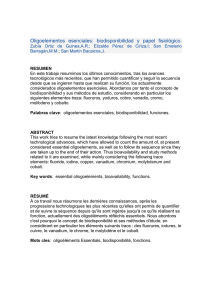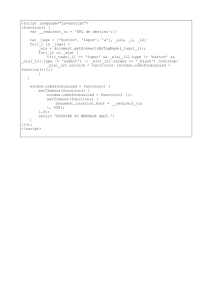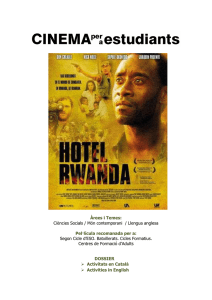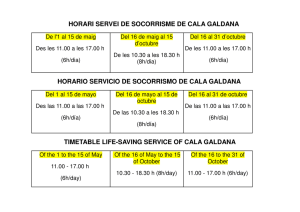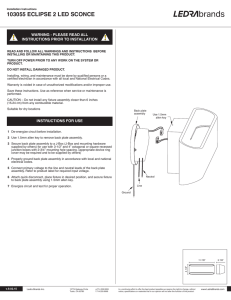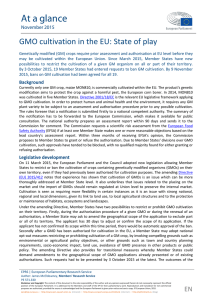D`on provenen les molècules precursores de l`ADN i l`ATP? Biologia
Anuncio
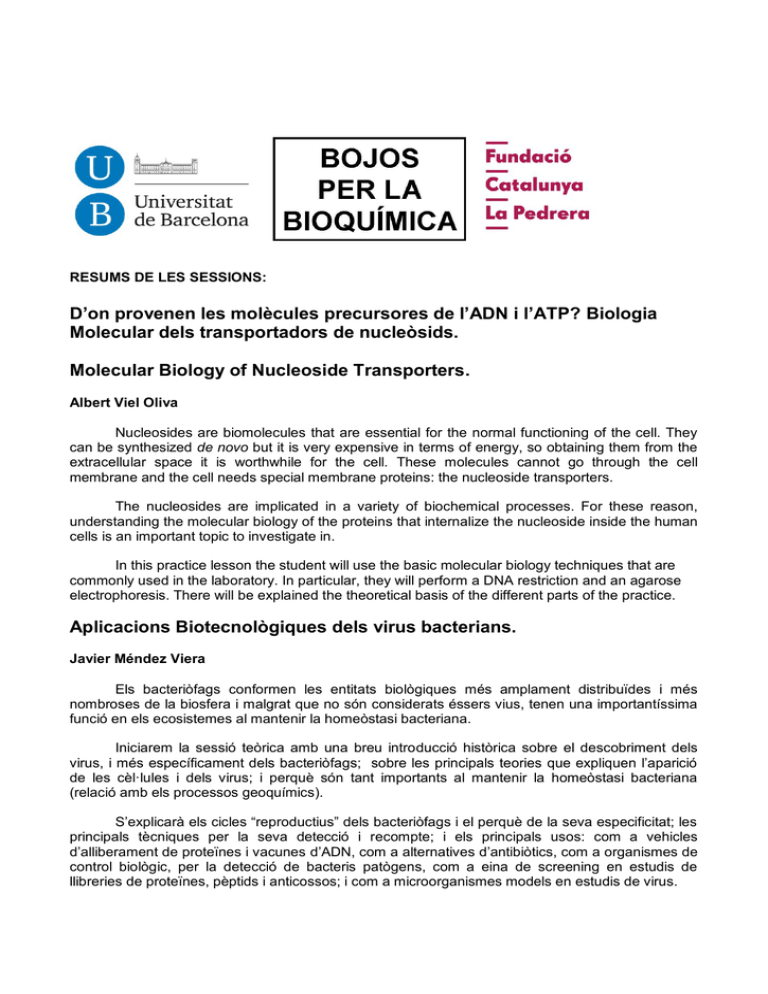
RESUMS DE LES SESSIONS: D’on provenen les molècules precursores de l’ADN i l’ATP? Biologia Molecular dels transportadors de nucleòsids. Molecular Biology of Nucleoside Transporters. Albert Viel Oliva Nucleosides are biomolecules that are essential for the normal functioning of the cell. They can be synthesized de novo but it is very expensive in terms of energy, so obtaining them from the extracellular space it is worthwhile for the cell. These molecules cannot go through the cell membrane and the cell needs special membrane proteins: the nucleoside transporters. The nucleosides are implicated in a variety of biochemical processes. For these reason, understanding the molecular biology of the proteins that internalize the nucleoside inside the human cells is an important topic to investigate in. In this practice lesson the student will use the basic molecular biology techniques that are commonly used in the laboratory. In particular, they will perform a DNA restriction and an agarose electrophoresis. There will be explained the theoretical basis of the different parts of the practice. Aplicacions Biotecnològiques dels virus bacterians. Javier Méndez Viera Els bacteriòfags conformen les entitats biològiques més amplament distribuïdes i més nombroses de la biosfera i malgrat que no són considerats éssers vius, tenen una importantíssima funció en els ecosistemes al mantenir la homeòstasi bacteriana. Iniciarem la sessió teòrica amb una breu introducció històrica sobre el descobriment dels virus, i més específicament dels bacteriòfags; sobre les principals teories que expliquen l’aparició de les cèl·lules i dels virus; i perquè són tant importants al mantenir la homeòstasi bacteriana (relació amb els processos geoquímics). S’explicarà els cicles “reproductius” dels bacteriòfags i el perquè de la seva especificitat; les principals tècniques per la seva detecció i recompte; i els principals usos: com a vehicles d’alliberament de proteïnes i vacunes d’ADN, com a alternatives d’antibiòtics, com a organismes de control biològic, per la detecció de bacteris patògens, com a eina de screening en estudis de llibreries de proteïnes, pèptids i anticossos; i com a microorganismes models en estudis de virus. GMO plants, a friend or a foe? And are they among us? Joana Rossell Genetic Modified Organisms, widely known as GMO, have represented a great technological advance in our time, not only for the challenge itself but also for the countless uses they promise to provide. GMO are have genetic modifications such as mutations, deletions and insertions of genes that come from other species. This is achieved through diverse techniques such as introduction of genetic material with an injection, virus or by turning cell membrane permeate. There are 27 approved GMO plants that are currently cultivated, 17 of them are food crops. GMO regulation is strong in Europe, allowing some of the available GMO varieties and requiring specific label for food containing more than 0.9% of GMOs. But can we be sure that we are eating GMO free food? We will test for the presence of GMOs in different food products using a PCR and DNA electrophoresis to detect, or not, to different DNA sequences that are present in most of the GMO crops that are approved for distribution around the world. Different food products will be chosen, a section of their DNA amplified using PCR and an agarose gel electrophoresis will be used to identify the presence or absence of GMO sequences. Apart from the interest in the experimental part, an idea exchange and debate about GMOs is warmly welcome!!! Multidimensional microscopy. Manel Bosch Light microscopy has come a long way since the first experiments in the seventeenth century by Robert Hooke and van Leeuwenhoek. The evolution of the technology and optics has allowed optical imaging to move from drawings to three dimensional reconstructions or real time movies. This evolution has increased the beauty of what is observed under the microscope but more important, has also made possible data reproducibility and quantitative analysis. Nowadays it is possible to make a movie of a live cell entering mitosis having a look at the same time and in the three dimensions of the cell to, for instance: the nuclei, the actin cytoskeleton and the microtubules. In fact the direct visualization of biological processes like the cell cycle or the gastrulation of an embryo is becoming routine in a modern biomedical research laboratory. During the theoretical session of the course “Bojos per la Bioquímica” we will explain the evolution of optical microscopy up to the innovations of the field that are on the horizon. Later in the practical sessions we will see some of this “routine” observations using different type of optical microscopes and contrast techniques. Finally we will focus on the analysis of the images obtained with the microscopes to understand how numerical data can be obtained from them. A computational approach to Biological questions: Modelization of gene regulatory Networks. Igor Marín de Mas With the advent of microarrays and other 'omic technologies, the amount of biological data has increased exponentially. These technologies provide a huge amount of data that is increasing the demand for tools to assist the analysis and extraction of meaningful biological information. Computational approaches are becoming an important field in systems biology because it provides tools that allow us to discern the mechanisms underlying the behavior of complex systems such as biological systems using big data bases from omic technologies. In this activity, the students will have a first contact with the computational modelization of biological systems. Specifically, it will be focused on discrete models used for modeling interaction networks such as gene regulatory networks. In this approach, both the evolution rules and the partial knowledge about the structure and the behavior of the network are formalized using a common constraint-based language. The use of this formal approach is relevant and applicable to address questions raised by biologists about such networks. This activity will be divided in two classes. An approximate guide of each class is described below: In the first class (2 hours) we will work on the consolidation and understanding of some important concepts necessaries for the modelization of interaction networks and more specifically gene regulatory networks. We will see how the microarrays and other technologies that measure the gene expression levels can provide biological data in order to extract meaningful knowledge of our biological system. We will also see why is necessary the use of computational tools to decipher the mechanism underlying biological processes. We will focus on discrete models based on R. Thomas formalism as computational tool. Finally we will see how the gene expression data obtained experimentally can be integrated into a model describing a gene regulatory interactions network in order to obtain a qualitative understanding of the network dynamics In the second class (4 hours) the students will consolidate all the concepts explained in the first class. For this aim we will design a discrete model describing a small gene regulatory network, after this we will use some experimental observations such gene expression data or phenotypic evidences to constrain the possible solutions. In this practical class we will see how our computational tool can give meaningful biological information about the network dynamics and how it can affect the biological processes. At the end of this activity the students will have a basic knowledge of computational modeling of gene regulatory networks using discrete models based on R. Thomas formalism. Fermentacions (bones i dolentes) i llevats. Javier Méndez Viera Sense els enzims la vida tal i com la coneixem no tindria lloc, doncs són els catalitzadors que agilitzen l’activitat bioquímica de tots els éssers vius. Iniciarem la sessió teòrica amb una breu introducció sobre l’estructura tridimensional de les molècules orgàniques, els tipus d’enllaços i la importància que tenen en la conformació tridimensional de les molècules processos com la ciclació. S’explicarà que és la estereoisomeria i la seva importància en el àmbit de la bioquímica. Es repassaran conceptes com els nivells d’organització de les proteïnes; el paper dels enllaços disulfurs i els ponts d’hidrogen en el manteniment de l’estructura secundària; i el paper de les modificacions post-traduccionals i la seva funció en el plegament. Usant com a model enzimàtic l’hexoquinasa es realitzarà la consulta de bases de dades online per mostrar als alumnes un petit tast de bioinformàtica. Per acabar, es farà un petit recorregut per les principals vies metabòliques i alguns dels processos de regulació de la seva activitat. Bioquímica a través d’internet, aquesta hamburguesa porta carn de cavall? Carlos Giménez Esteban L’objectiu és presentar als participants dues eines informàtiques: En primer lloc es treballarà el llenguatge SMILES™ i la seva aplicació mitjançant programari lliure (JMol) i gratuït (Chemsketch) per a la representació tridimensional de molècules orgàniques, amb la intenció d’aprofitar les possibilitats d’aquests recursos, que poden ajudar els participats a comprendre millor alguns dels principis bàsics de la geometria molecular. Es farà una introducció al funcionament del llenguatge SMILES™ i es plantejaran exercicis pràctics d’aplicació, així com exemples de la presència i ús d’aquest llenguatge en diversos entorns online. En segon lloc, es presentaran alguns exemples d’aprofitament de la informació existent a les principals bases de dades moleculars online de seqüències genòmiques i proteíniques. Es mostrarà un exemple de sistema per a orientar les cerques en aquests entorns a partir de la guia NAVIGENE. En aquest cas es donaran eines als participants per tal que esdevinguin capaços de plantejar de forma autònoma les cerques i consultes necessàries en aquestes bases de dades per tal de resoldre les situacions problema plantejades. Es proposarà igualment als participants la possibilitat de generar per sí mateixos nous contextos que puguin ser resolts amb les eines treballades. Ús d’animals experimentals en el laboratori d'investigació. Silvia Busquets Rius i Miriam Toledo Soler The session “Use of animal models in research laboratories” will comprise the following items to be treated and adapted for the understanding of the students: (1) importance of animal models for research (2) examples of significant literature (experiments could not have been done without an animal model, transgenic cloning ....) (3) importance in drug discovery and development, (4) use of the animal models in pharmaceutical companies, (5) control and regulation of the animal use in reseach by Ethic Committees, (6) alternatives to the use of animal models. Moreover, it will be introduced the practical session because some of the manipulation of the animals (always performed by the monitors) requires some previous theoric introduction: handling of animals, anesthesia, routes of administration, measurement of muscle strength and physical activity, training with the treadmill, behavioral tests: forced swimming test and resident-intruder test, harmless quantification of glucose levels from blood.
